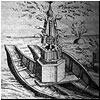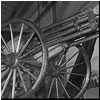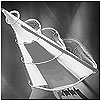|
|
|
|
HISTORY | ||||||||
 |
FIRE ARROWS: Origins of rocketry Following wheel and bow and arrows, the first rockets originated too deep in history to mark their exact birth date or name their creators. Indisputable is the invention of gun powder in China which paved the way to fire-arms and to the first known solid-propellant rockets, likely in the early 13th century. |

|
|||||||
 |
THE FIRST GOLDEN AGE: The Congreve missiles In India, Mysorean princes began using battlefield rockets in the 18th century. The exotic weapon looked impressive enough to the British military to initiate its own rocket research. The son of a leading British artillery specialist William Congreve took on the effort to improve upon the Indian designs and organize production of rockets at the Woolwich arsenal near London. |
||||||||
|
TAMING THE FIRE: Rocketry in Russia before the 20th century Before Korolev, before Tsiolkovskiy, Russian artillery engineers fascinated with missiles tried hard to tame rocket power. It took centuries to perfect these ancient machines. |
|||||||||
|
Although the Russian scientific elite was primarily concentrated in centers such as Moscow and St. Petersburg, far from two capitals, a modest physics teacher conceived some of the most remarkable ideas about the future of the human race. Almost unknown to its contemporaries, Tsiolkovskiy's work decades later was universally accepted as a theoretical foundation of modern astronautics. (80) |
|||||||||
FROM IDEAS TO PRACTICE: Rocket research at GDL In 1917, the Bolshevik revolution spurred profound changes in Russia. The new leaders of Soviet Russia conducted a ruthless policy of turning an agrarian peasant society into an industrial power. At the same time, the Soviet government spared no effort, in equipping the Red Army with new weapons. In line with this strategy, on March 1, 1921, the authorities created GDL, a laboratory for research in rocketry, to be led by Nikolai Tikhomirov. Researchers at GDL worked tirelessly on perfecting military missiles and developing new types of solid rocket fuel, which would allow the new weapons to compete with artillery. (82) |
|||||||||
 |
FROM ENTHUSIASM TO PROFESSION: Rocket research at GIRD At the beginning of the 1930s, the Soviet government sanctioned the creation of several research groups, which united rocket enthusiasts. Such organizations (known as GIRD -- for Group for Investigation of Reactive Movement) were established in Moscow, Leningrad and, later, in Baku, Tiflis, Arkhangelsk, Novocherkassk, Bryansk and other cities. (2) In Moscow, thanks to the efforts of Sergei Korolev and Fridrikh Tsander, the government-sponsored Society for the Advancement of Defense, Aviation and Chemical Technology, Osaviakhim, agreed to fund GIRD. GIRD-09 rocket; GIRD-09 engine |
||||||||
|
BY TRIAL AND ERROR: Rocket research at RNII In the fall of 1933, the Soviet government, merged GIRD and GDL, creating the Reactive Scientific Research Institute, or RNII. Ivan Kleimenov was appointed as chief of the institute. The consolidation of several smaller research organizations within RNII brought a variety of projects as well as personalities under a single roof. RNII continued the development of solid-propelled missiles initiated in GDL. It absorbed the research in the field of liquid-fueled rocketry inherited from GIRD, including the development of a rocket-powered glider and a series of winged missiles. |
|||||||||
|
SECRET WEAPONS: German rocketry during World War II During World War II, the Nazi regime in Germany funded an unprecedented effort to build rocket weapons. Capitalizing on the experience accumulated by German rocket enthusiasts since the second half of the 1920s, a group of engineers at a secret center in Peenemunde developed the A-4 ballistic missile of incomparable size and range. The A-4 became a paramount of a multi-fold rocket development program, which also included antiaircraft and cruise missiles, as well as piloted rocket-propelled fighter planes. |
|||||||||
GERMAN LEGACY: Russian rocketry after World War II As the Great Patriotic War of 1941-1945 was drawing to a close, Russian rocket designers learned about German missiles, whose size and range exceeded their wildest expectations. German experience helped Russian rocket scientists make a giant leap forward in the second half of the 1940s. An entire new industry and new class of weapons was born, while their creators had already conceived dreams of sending spacecraft into orbit around the Earth. |
|||||||||
IN THE NEW WORLD: Rocket development programs in the US Back in the 19th century, a visionary French writer, Jules Verne, made Florida an origin of its fictional journey to the Moon -- a brilliant prediction of the future role the United States would play in the history of space exploration. Jules Verne's prophecy started coming true in March 1926, when America's own visionary -- Robert Goddard -- launched world's first rocket powered by liquid propellant. As often in history, Goddard's pioneering feat was met with ridicule or indifference, leaving the rocket development in the United States a low-key and low-budget affair. |
|||||||||
|
5TH REPUBLIC: Origin of the French rocketry In 1958, Charles de Gaulle, the hero of the anti-Nazi resistance movement during World War II, returned to power in France. His ascent to presidency was backdropped by Soviet victories in the race with the United States to reach the outer space. In the face of the Soviet technological and military prowess, Gaullists argued, France would be too naive in depending on the United States for protection. As a result, de Gaulle committed the nation to full technological independence from the United States, including complex and expensive fields of nuclear technology and rocketry. |
|||||||||
| TYPES OF ROCKETRY | |||||||||
|
COLD WAR WARRIORS: Long-range ballistic missiles The Cold War between the United States and the Soviet Union (1945-1991) gave birth to enormous fleet of the ballistic missiles, which became the main weapon of the superpowers. Many believe that the missiles' invulnerability, combined with the destructive power of nuclear weapons, provided the so-called Mutually Assured Destruction or MAD, which became a cornerstone of the Soviet-American relations from the end of the 1960s and up to the desintegration of the Soviet Union in 1991. Special: Cuban missile crisis; |
|||||||||
|
WINGED PHANTOMS: Long-range cruise missiles Before intercontinental ballistic missiles became the "crown jewel" of the Cold War superpowers, rocket designers on both sides of the Atlantic also experimented with cruise missiles -- a symbiosis of a missile and an airplane. Not before several large experimental cruise missiles had been developed, Khrushchev's government in the USSR abandoned the idea in favor of ICBM. Yet, short and medium range cruise missiles became a new class of weapons. |
|||||||||
|
FROM THE DEPTH OF THE SEA: Submarine-launched ballistic missiles The most dangerous weapon of the Cold War (1945-1991) were submarines armed with missiles. Hidden beneath the surface of the sea, these underwater nuclear-powered giants were carrying dozens of missiles, which in their turn were armed with multiple nuclear warheads. |
|||||||||
| INTO
SPACE: Launch vehicles
With the launch of Sputnik in 1957, the Soviet Union opened the Space Age. In the following decades several generations of the space boosters were developed in the country. Most of them derived from ballistic missiles originally designed to carry nuclear warheads, however some were conceived specifically to deliver cargo into space. |
|||||||||
 |
ONE STAGE TO ORBIT: Hypersonic vehicles From the dawn of space age, engineers worked on "hypersonic" vehicle -- those capable of flying in the atmosphere at speeds of Mach 4 and faster. The resolution of enormous technical challenges long facing hypersonic flight promised more advanced cruise missiles, a new-generation of launch vehicles, super-fast suborbital aircraft and, possibly, manned space planes capable of reaching orbit after a horizontal takeoff from a runway. |
||||||||